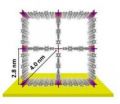(Press-News.org) New York, NY—December 5, 2012—Computer scientists at Columbia's School of Engineering and Applied Science have published a study in the November 2012 issue of The American Journal of Human Genetics (AJHG) that demonstrates a new approach used to analyze genetic data to learn more about the history of populations. The authors are the first to develop a method that can describe in detail events in recent history, over the past 2,000 years. They demonstrate this method in two populations, the Ashkenazi Jews and the Masai people of Kenya, who represent two kinds of histories and relationships with neighboring populations: one that remained isolated from surrounding groups, and one that grew from frequent cross-migration across nearby villages.
"Through this work, we've been able to recover very recent and refined demographic history, within the last few centuries, in contrast to previous methods that could only paint broad brushstrokes of the much deeper past, many thousands of years ago," says Computer Science Associate Professor Itsik Pe'er, who led the research. "This means that we can now use genetics as an objective source of information regarding history, as opposed to subjective written texts."
Pe'er's group uses computational genetics to develop methods to analyze DNA sequence variants. Understanding the history of a population, knowing which populations had a shared origin and when, which groups have been isolated for a long time, or resulted from admixture of multiple original groups, and being able to fully characterize their genetics is, he explains, "essential in paving the way for personalized medicine."
For this study, the team developed the mathematical framework and software tools to describe and analyze the histories of the two populations and discovered that, for instance, Ashkenazi Jews are descendants of a small number—in the hundreds—of individuals from the late medieval times, and since then have remained genetically isolated while their population has expanded rapidly to several millions today.
"Knowing that the Ashkenazi population has expanded so recently from a very small number has practical implications," notes Pe'er. "If we can obtain data on only a few hundreds of individuals from this population, a perfectly feasible task in today's technology, we will have effectively collected the genomes of millions of current Ashkenazim." He and his team are now doing just that, and have already begun to analyze a first group of about 150 Ashkenazi genomes.
The genetic data of the Masai, a semi-nomadic people, indicates the village-by-village structure of their population. Unlike the isolated Ashkenazi group, the Masai live in small villages but regularly interact and intermarry across village boundaries. The ancestors of each village therefore typically come from many different places, and a single village hosts an effective gene pool that is much larger than the village itself.
Previous work in population genetics was focused on mutations that occurred very long ago, say the researchers, and therefore able to only describe population changes that occurred at that timescale, typically before the agricultural revolution. Pe'er's research has changed that, enabling scientists to learn more about recent changes in populations and start to figure out, for instance, how to pinpoint severe mutations in personal genomes of specific individuals—mutations that are more likely to be associated with disease.
"This is a thrilling time to be working in computational genetics," adds Pe'er, citing the speed in which data acquisition has been accelerating; much faster than the ability of computing hardware to process such data. "While the deluge of big data has forced us to develop better algorithms to analyze them, it has also rewarded us with unprecedented levels of understanding."
###
Pe'er's team worked closely on this research with study co-authors, Ariel Darvasi, PhD of the Hebrew University of Jerusalem, who was responsible for collecting most of the study samples, and Todd Lencz, PhD of Feinstein institute for Medical Research, who handled genotyping of the DNA samples. The team's computing and analysis took place in the Columbia Initiative in Systems Biology (CISB).
This research is supported by the National Science Foundation (NSF). The computing facility of CISB is supported by the National Institutes of Health (NIH).
Columbia Engineering
Columbia University's Fu Foundation School of Engineering and Applied Science, founded in 1864, offers programs in nine departments to both undergraduate and graduate students. With facilities specifically designed and equipped to meet the laboratory and research needs of faculty and students, Columbia Engineering is home to NSF-NIH funded centers in genomic science, molecular nanostructures, materials science, and energy, as well as one of the world's leading programs in financial engineering. These interdisciplinary centers are leading the way in their respective fields while individual groups of engineers and scientists collaborate to solve some of modern society's more difficult challenges.
http://www.engineering.columbia.edu/
This press release is available in German.
Researchers of the KIT Institute of Functional Interfaces (IFG), Jacobs University Bremen, and other institutions have developed a new method to produce metal-organic frameworks (MOFs). By means of the so-called liquid-phase epitaxy, the scientists succeeded in producing a new class of MOFs with a pore size never reached before. These frameworks open up interesting applications in medicine, optics, and photonics. The new class of MOFs, called "SURMOF 2", is presented in the "Nature Scientific Reports" journal.
Metal-organic ...
BLOOMINGTON, Ind. -- At a Bloomington, Ind., toy store, kids ages 8 to 12 gather weekly to trade Pokemon cards and share their mutual absorption in the intrigue and adventure of Pokemon.
This may seem an unlikely source of material to test theories in cognitive neuroscience. But that is where Indiana University brain scientists Karin Harman James and Tom James were when an idea took hold.
"We were down at the club with our son, watching the way the kids talked about the cards, and noticed it was bigger than just a trading game," Tom James said.
Pokemon has since ...
PHILADELPHIA — Roughly one-fifth of Americans take low-dose aspirin every day for heart-healthy benefits. But, based on either urine or blood tests of how aspirin blocks the stickiness of platelets – blood cells that clump together in the first stages of forming harmful clots – up to one third of patients are deemed unlikely to benefit from daily use. Such patients are called "aspirin resistant." Clots are the main cause of most heart attacks and strokes.
In people who have suffered a heart attack, low-dose aspirin reduces the chances of a second event by about one fifth, ...
PROVIDENCE, R.I. – If you're thinking that little old lady driving 35 miles per hour in the passing lane shouldn't be behind the wheel, you may be right. Studies at Rhode Island Hospital, and elsewhere, have shown that our driving abilities decline with age, and for those with cognitive issues such as dementia, it can be even worse.
A standardized road test – much like the one teenagers take to receive their learner's permit and driver's license – is often used to measure an individual's performance, including those of older adults. But researchers at the Rhode Island ...
GAINESVILLE, Fla. — A new study co-authored by a University of Florida researcher provides the first direct chronological test of sequence stratigraphy, a powerful tool for exploring Earth's natural resources.
The model allows geologists to better understand how sedimentary rocks are related to one another in time and space and predict what types of rocks are located in different areas. The information may help scientists more reliably interpret various aspects of Earth's history such as long-term climate changes or extinction events, and also benefit companies searching ...
University of Rochester Medical Center scientists are testing a new approach to speed a patient's recovery of blood counts during a vulnerable period after a stem-cell transplant, according to a study published in the journal Stem Cells.
Laura M. Calvi, M.D., and Rebecca L. Porter, an M.D./Ph.D. student in Calvi's lab, reported that prostaglandin E2 (PGE2), a drug previously used to treat stomach ulcers, boosts blood production following an assault on the bone marrow from radiation or chemotherapy. Although their study was done in mice, Calvi believes it has significance ...
A new study finds differences in the ways that participation in Alcoholics Anonymous (AA) helps men and women maintain sobriety. Two Massachusetts General Hospital (MGH) investigators found that, while many factors are helpful to all AA participants, some were stronger in men and some in women. For example, avoidance of companions who encourage drinking and social situations in which drinking is common had more powerful benefits for men, while increased confidence in the ability to avoid drinking while feeling sad, depressed or anxious appeared to be more important for ...
VIDEO:
New research from Western University could lead to better treatments for Post-Traumatic Stress Disorder (PTSD) and drug addiction by effectively blocking memories. Steven Laviolette and Nicole Lauzon describe how...
Click here for more information.
New research from Western University could lead to better treatments for Post-Traumatic Stress Disorder (PTSD) and drug addiction by effectively blocking memories. The research performed by Nicole Lauzon, a PhD candidate ...
ITHACA, N.Y. – A bit reminiscent of the Terminator T-1000, a new material created by Cornell researchers is so soft that it can flow like a liquid and then, strangely, return to its original shape.
Rather than liquid metal, it is a hydrogel, a mesh of organic molecules with many small empty spaces that can absorb water like a sponge. It qualifies as a "metamaterial" with properties not found in nature and may be the first organic metamaterial with mechanical meta-properties.
Hydrogels have already been considered for use in drug delivery – the spaces can be filled with ...
Johns Hopkins researchers have used a small synthetic molecule to stimulate cells to move and change shape, bypassing the cells' usual way of sensing and responding to their environment. The experiment pioneers a new tool for studying cell movement, a phenomenon involved in everything from development to immunity to the spread of cancer.
"We were able to use synthetic molecules small enough to slip inside the cell and activate a chemical reaction controlling cell movement, bypassing most of the steps that usually lead up to this reaction," says Andre Levchenko, Ph.D., ...



